25 Most Influential Books in Business 2010–2020
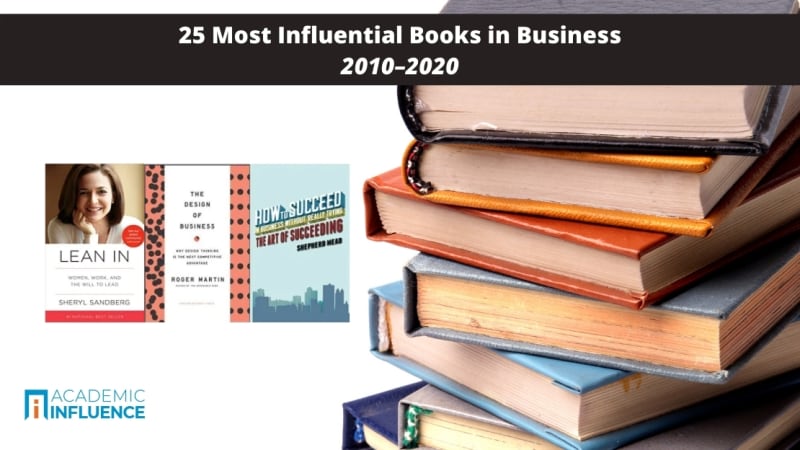
Business, as an academic discipline, is the study of one aspect of the economy—namely, the administration and management of the private companies and firms of all sizes, which are the main producers of consumer and capital goods in a free-market economy.
In practice, this notion of business as the principal object of study in dedicated academic institutions called “business schools” is quite broad, encompassing the banking and financial industries, as well as the ways in which all of the above interact with the legal and justice systems and with government.
With these considerations in mind, we have compiled a list of the most influential books in business of the past decade (2011–2021). We have assigned an objective measure of “influence” to each book on the basis of the number of references it has received in both the academic literature and the popular media.
Note that our list does not necessarily represent the most popular business books overall published during the past ten years, nor is it a straightforward list of business bestsellers during that time frame.
The main reason is that we have excluded business textbooks and technical reference works, as well as sacred texts and all but a few classic fictional works which may contain business-related material.
Rather, our list provides you with the 25 books on business that have had the greatest combined academic and popular impact over the past decade.
Otherwise, read on for a look at The 25 Most Influential Books in Business.
25 Most Influential Books in Business
1.Lean In: Women, Work, and the Will to Lead
By: Sheryl Sandberg , 2013
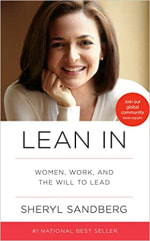

Sandberg (b. 1969) is Chief Operating Officer of Facebook and the founder of LeanIn.Org. Previously, she served as Vice President of Global Online Sales and Operations at Google, and before that as Chief of Staff at the US Treasury Department.
The purpose of this book is to convey to women hoping to climb a corporate ladder, first, what they are up against, and second, what they should do to overcome the obstacles in their path.
The author raises many important issues. Among them:
- The corporate world rewards commitment, so women cannot afford to be half-hearted about their careers.
- It rewards ambition, not likability, so women need to assert themselves and let the chips fall where they may.
- It rewards effectiveness, so women must get the job done and avoid making excuses.
Sandberg presents herself as a feminist, but she has been heavily criticized as essentially saying that to succeed in business, women must adopt male character traits, while men do not need to change.
For this reason, the book was harshly criticized by many feminist and leftist reviewers as promoting the interests of the capitalist patriarchy.
2.The Design of Business: Why Design Thinking is the Next Competitive Advantage
By: Roger Martin , 2009
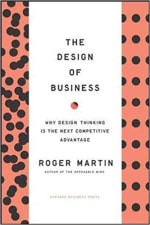

Martin (b. 1956) is former Dean of the Rotman School of Management at the University of Toronto.
In this book, Martin lays out his analysis of how problem-solving in the context of business innovation ought to proceed. He calls his approach to problem-solving “design thinking.”
First, the author explains how design thinking incorporates what he calls a “knowledge funnel,” which is his metaphor for a systematic approach to innovation. Martin’s knowledge funnel consists of three stages, namely:
- Mystery
- Heuristic
- Algorithm
The “mystery” stage is the exploratory phase of some problem that needs to be solved or some innovation that needs to be implemented.
In the next stage of the funnel, the exploration of the mystery leads into the “heuristic” stage, which means the development of a provisional solution in the form of a rule of thumb.
The final stage of the funnel is the “algorithm” stage. In this stage, the heuristic (which is general by definition) is developed into a specific, well-defined, and executable formula. This transforms a “mysterious”—that is, a vague, difficult, and/or complicated—problem into a manageable, simple one.
The author points out that design thinking incorporates both intuitive thinking in the first two funnel stages and analytical thinking in the last stage.
Martin claims that one of the most important failures of current business and management thinking is its over-emphasis on inductive and deductive thinking alone. Induction is inference to general laws from individual cases, while deduction is inference from accepted premises via truth-preserving logical form to a valid conclusion.
In addition, Martin claims that “abductive” inference (AKA “inference to the best explanation”) is a crucial feature of design thinking, without which one cannot pass successfully through the knowledge funnel. Abduction is inference to the law or set of facts which best explains the data in question.
3.How to Succeed in Business Without Really Trying: The Dastard’s Guide to Fame and Fortune
By: Shepherd Mead , 1952
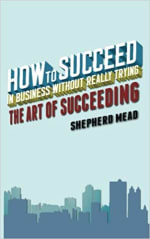

Mead (1914–1994) was an advertising executive and author. Born in St. Louis, he obtained a bachelor’s degree in 1936 from Washington University in St. Louis.
After graduating from college, Mead got a job with the New York–based advertising firm, Benton & Bowles. Beginning in the mail room, Mead eventually worked his way up to become a vice president of the company. He left the firm in 1956 after his publishing success.
How to Succeed in Business Without Really Trying is a satire in the form of a pseudo–instruction manual. It is loosely based on real manuals that were proliferating during the postwar period in middle-level managers’ offices throughout corporate America, which gave advice to employees about how to get ahead in their careers.
Mead based his satire on his own experiences working for Benton & Bowles. The book was a national bestseller when it was originally published in 1952.
In 1961 it was made into a successful Broadway musical with music and lyrics by Frank Loesser and book by Abe Burrows and others. The musical invented several central characters and a plot, turning the original “how-to manual” form of the book into a more-accessible, novelistic artistic form.
In 1967 the musical was made into a film directed by David Swift, with choreography by Bob Fosse. Rudy Vallee and Robert Morse played the starring roles in both the musical and the film.
How to Succeed in Business Without Really Trying was reprinted in 2014 with a new subtitle, “The Art of Succeeding.”
4.Blue Ocean Strategy: How to Create Uncontested Market Space and Make the Competition Irrelevant
By: W. Chan Kim and Renée Mauborgne , 2004
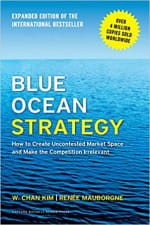

Kim (b. 1951) is a Korean-born Professor of Strategy and Management at INSEAD in Fontainebleau, France, in the Paris suburbs. He is also Co-Director (with Mauborgne) of INSEAD’s Blue Ocean Strategy Institute.
Mauborgne (b. 1963) is an American-born Distinguished Fellow of Strategy and International Management at INSEAD, as well as Co-Director (with Kim) of the Blue Ocean Strategy Institute.
Founded in 1957, INSEAD is an acronym for Institut Européen d’Administration des Affaires [European Institute for Business Administration]. Today, INSEAD advertises itself as “The Business School for the World,” with campuses in Fontainebleau, Abu Dhabi, Singapore, and San Francisco.
“Blue Ocean Strategy” is an innovative management concept and program developed by Kim and Mauborgne, which they institutionalized in INSEAD’s Blue Ocean Strategy Institute, and eventually turned into the book under consideration here.
In a nutshell, “Blue Ocean Strategy,” as presented in the book, refers to the search for new business opportunities in brand-new markets spaces. The discovery and development of such markets is especially desirable because as-yet-untapped markets have maximum growth potential and so present opportunities for lasting success.
“Blue Ocean Strategy” also recommends itself because it allows companies to avoid fierce, head-on competition in already-overcrowded industries—competition that often results figuratively in a “red ocean” of desperate rivals thrashing about in a bloody sea of ever-shrinking profits.
An expanded edition of the book was published in 2015.
5.The Fortune at the Bottom of the Pyramid: Eradicating Poverty Through Profits
By: C.K. Prahalad, 2004
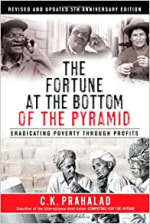

Coimbatore Krishnarao Prahalad (1941–2010) was born in the city of Coimbatore in the state of Tamil Nadu in India. His father was both a Tamil scholar and a judge in the capital and largest city of Tamil Nadu, namely Chennai (formerly known as Madras).
After receiving his bachelor’s degree in physics from the University of Madras, Prahalad worked for Union Carbide for four years. He then did graduate work in business management at the Indian Institute of Management in Ahmedabad, the capital of the state of Gujarat.
Prahalad then left for the US, where he received his doctorate in business administration in 1975 from Harvard Business School. After three years back in India, he accepted a tenure-track appointment at the University of Michigan’s Stephen M. Ross School of Business.
At the time of his retirement in 2005, Prahalad had attained the title of Paul and Ruth McCracken Distinguished University Professor of Corporate Strategy at the Ross School.
In 2002, Prahalad co-authored a paper entitled “The Fortune at the Bottom of the Pyramid,” which was published in the online academic business journal, strategy + business. His co-author was Stuart L. Hart, a professor at the University of North Carolina’s Kenan-Flagler Business School.
Prahalad expanded the paper into the book under consideration here, published two years later.
The basic message of the article and the book is quite simple: because the base of the pyramid—the world’s poor—is so large, there is a huge opportunity for global corporations to do well in terms of profits while at the same time doing good by investing in developing countries.
The book was reprinted in 2019.
6.The Big Short: Inside the Doomsday Machine
By: Michael Lewis , 2010
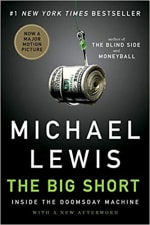

Lewis (b. 1960) is a financial journalist and author. He was born in New Orleans, the son of a corporate attorney father and a social activist mother.
After receiving his master’s degree in economics from the London School of Economics, Lewis went to work as an analyst with the celebrated international investment banking firm, Salomon Brothers—an experience he described in his first book, Liar’s Poker, in 1989.
A decade later, Lewis wrote a follow-up book on Silicon Valley. Then, in 2003, he catapulted to publishing stardom with his bestseller, Moneyball, about the sabermetric system of analysis of baseball statistics. A popular film based on Moneyball released in 2011 further contributed to Lewis’s reputation and celebrity.
Among the several other books that Lewis published after the book under consideration here, Flash Boys, published in 2014—which examined the role of computers and high-frequency trading on the broader stock market—is particularly worthy of mention.
The Big Short, however, is perhaps Lewis’s most important work, as its subject—the manipulations underlying the stock market collapse of 2008—is of such great historical importance. In the book, Lewis details how a market in credit default swaps was invented to bet against (“short”) the collateralized debt obligation bubble that had arisen in the housing industry due to a variety of factors. Those who participated in the “big short” thus profited hugely from the financial crisis.
A film based on this book, also called The Big Short, was released in 2015. It was directed by Adam McKay and starred Brad Pitt, Christian Bale, Steve Carell, and Ryan Gosling, among others.
7.Trump: The Art of the Deal
By: Donald Trump and Tony Schwartz , 1987
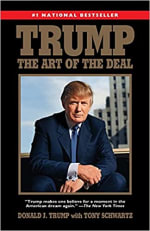

Trump (b. 1946) is a real estate developer and former host of the “reality” TV show The Apprentice from 2004 until 2015. He went on to serve as 45th President of the US from 2017 to 2021.
Thus, this book was written long before Trump’s celebrity as a television personality, much less as a politician.
Schwartz (b. 1952) is a journalist and book author who specializes in business affairs.
The book is a combination of a biography of Trump and an exposition of his insights into the process of successfully negotiating business deals of all sorts. It includes historical details of the negotiations that led to many of his best-known projects—including the Grand Hyatt Hotel and the Trump Tower, both in New York City—as well as an 11-step formula that he claims he followed in these successful negotiations.
It has been claimed that Trump’s approach to negotiating was heavily influenced by Norman Vincent Peale (1898–1993), whose enormously popular bestseller, The Power of Positive Thinking, was first published in 1952.
Trump: The Art of the Deal has been reprinted several times, notably in 2015 in the run-up to Trump’s successful 2016 presidential campaign.
8.More Money Than God: Hedge Funds and the Making of a New Elite
By: Sebastian Mallaby , 2010


Mallaby (b. 1964) is a British-born, Oxford-educated economics and financial journalist, columnist, and book author.
In this book, Mallaby presents a history of the hedge fund industry as it developed in the US over the past several decades. More specifically, he explains the concept of a hedge fund and depicts the people, institutions, and investment tools that were involved in the development of the industry.
Written for a general audience, More Money Than God has been praised by one critic as the “first authoritative history of the hedge fund industry.” Another critic has written that the book is “The fullest account we have so far of a too-little-understood business that changed the shape of finance and no doubt will continue to do so.”
The author has published two other books on economic and financial subjects, in addition to the one under consideration here, namely, The World’s Banker: A Story of Failed States, Financial Crises, and the Wealth and Poverty of Nations (2004) and The Man Who Knew: The Life and Times of Alan Greenspan (2016).
9.Clean Tech Nation: How the U.S. Can Lead in the New Global Economy
By: Ron Pernick and Clint Wilder , 2012
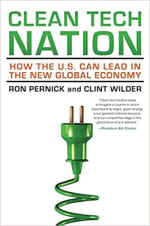

Pernick is a market research and business development entrepreneur. He has more than three decades of experience in the high-tech industry. Wilder has been an active business journalist since 1985. He specializes in the high-tech and clean-tech industries.
In 2000, Pernick and Wilder co-founded Clean Edge, Inc., a developer and publisher of thematic stock indexes, which tracks clean energy in the transportation, water, and electrical grid sectors. The firm’s first index—the Nasdaq Clean Edge Green Energy Index (CELS)—was launched in 2006.
The pair published their first book, The Clean Tech Revolution: The Next Big Growth and Investment Opportunity, in 2007. Clean Tech Nation is a follow-up to the authors’ 2007 book.
The book surveys the depth and breadth of the vast expansion of clean technology and renewable energy over the decade prior to the book’s publication. More particularly, it tracks the growth of wind power (wind turbines) and solar power (photovoltaic cells), demonstrating how these markets grew some twenty-fold over that time period.
The authors also identify the factors driving the global expansion of clean tech in China, Europe, and elsewhere, as well as the new economic opportunities created by this international trend.
10.The Lords of Strategy: The Secret Intellectual History of the New Corporate World
By: Walter Kiechel, III, 2010


Kiechel (b. 1946) is an editor, author, and journalist specializing in business affairs. Born in Nebraska, but raised in Alexandria, Virginia, he completed the joint JD/MBA program at Harvard Law School and Harvard Business School in 1977. Kiechel’s publishing career has included stints as Managing Editor of Fortune magazine and as Editorial Director of Harvard Business School Publishing, which publishes the Harvard Business Review.
For a time, Kiechel was a contributor to Fortune, as well, writing a weekly column titled “Office Hours.” In 1988, his selected Fortune columns were published as a book titled Office Hours: A Guide to the Managerial Life. Around this same time, he also hosted a weekly business television program on CNBC.
However, the book under consideration here is probably the Lords of Strategy is a history of the thinkers who, in the author’s estimation, have had the most profound impact on the development of business strategy since the 1960s.
The book contains chapters devoted to each of the following persons and entities: Bruce Henderson (1915–1992), Bill Bain (1937–2018), Frederick Gluck (b. 1935), Michael Porter (b. 1947), and the Harvard Business Review. Lords of Strategy was very favorably received, with one reviewer calling the book “inspiring” and saying that it tells the strategists’ story “with novelistic flair.”
11.Crippled America: How to Make America Great Again
By: Donald Trump , 2015
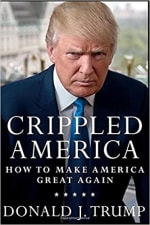

Trump (see #7 above) wrote this book as an accompaniment to his run for the US presidency in 2016. It was published in late 2015, then reprinted under the title Great Again: How to Fix Our Crippled America in the summer of 2016.
The book does two things. First, Trump presents his biography, including his reflections on his own character faults which led to the failure of his first two marriages. Second, he lays out his political and economic philosophy, including some of the specific plans in foreign and domestic policy he intends to pursue, if elected.
With respect to domestic policy, Trump maintains that his experience in the business world prepares him better than a political career in Washington would to fix what ails the American economy. Among the policies he proposes are the following: stopping illegal immigration in order to reduce competition among low-wage workers; lowering taxes on small-business owners and middle-income consumers to stimulate economic activity and capital investment; renegotiating international trade treaties to level the economic playing field; and revising federal regulations to incentivize the repatriation of American business firms that have been transferred overseas.
12.The Blue Economy: 10 years—100 innovations—100 million jobs
By: Gunter Pauli , 2010
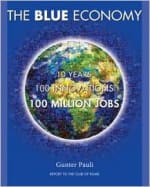

Pauli (b. 1956) was born in Antwerp, Belgium. Since 1994, he has resided in Japan. Pauli, who speaks seven languages fluently, frequently travels to South Africa. He holds a bachelor’s degree in economics from the University of Antwerp and an MBA from INSEAD, Fontainebleau (France).
An entrepreneur active in fields from business and science to culture, politics, and the environment, Pauli is the founder of Zero Emissions Research and Initiatives (ZERI).
Pauli has long been associated with the green movement. With this book, he challenges his allies in the conservation and sustainability movements to do better than they have heretofore. He maintains that the key to better concrete results in the environmental movement lies in implementing what he calls the “blue economy business model” (not to be confused with a different notion of “blue economy” relating to the exploitation of marine resources).
The book under consideration here explains the essential features of Pauli’s blue economy business model, which include a variety of innovative ideas for the cultivation of healthy environments and the provision of good nutrition, health care, and jobs in sustainable commerce to disadvantaged populations in developing countries around the world.
A second edition, The Blue Economy, Version 2.0: 200 Projects Implemented—US $4 Billion Invested—3 Million Jobs Created, was released in 2014; and a third edition, The Blue Economy 3.0: The Marriage of Science, Innovation and Entrepreneurship Creates a New Business Model That Transforms Society, was published in 2017.
13.The Cluetrain Manifesto: The End of Business as Usual
By: Rick Levin , Christopher Locke , Doc Searls , and David Weinberger , 2000


Weinberger (b. 1950) holds a PhD in philosophy from the University of Toronto. His co-authors include a music industry entrepreneur and workshop leader (Levin), a business analyst and speaker (Locke), and a journalist and blogger (Searls).
The book traces its origin to a manifesto consisting of 95 theses that was first published online in 1999. The number 95 would appear to be an allusion to the famous Ninety-Five Theses that Martin Luther (1483–1546) nailed to a church door in Wittenberg, Germany, in 1517, setting off the Protestant Reformation.
The book expands upon the manifesto, going into each of the 95 theses in greater detail. The theses may be grouped into several categories:
- The Internet is changing the nature of marketplaces.
- The use of hyperlinks connecting to additional information subverts preexisting organizational hierarchies.
- New Internet-based markets make available information that is often superior to the information available from businesses’ own websites.
- It is up to organizations to be proactive in exploiting new Internet markets.
- Traditional methods of business communications will have to change to adapt to the new market environment.
- Business organizations will have to establish new lines of internal communication via intranets to fully exploit the potential of new markets created by the Internet.
- New expectations and practices existing within the new marketplace will require a corresponding response from organizations.
A tenth-anniversary edition was published in 2011.
14.Wikinomics: How Mass Collaboration Changes Everything
By: Don Tapscott and Anthony D. Williams , 2006
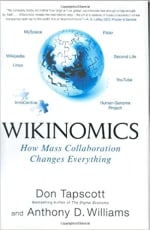

Tapscott (b. 1947) is a Canadian business executive, consultant, author, and speaker. He was born in Toronto, Ontario. Williams (b. 1974) is a Canadian consultant, researcher, and author. Tapscott is a former chancellor of Trent University in Peterborough, Ontario, as well as Executive Chairman of Blockchain Research Institute. He has authored or co-authored 14 books in addition to the one under consideration here.
This book is about the impact of open-source software and crowdsourcing on traditional business practices, resulting in a new phenomenon the author calls “mass collaboration.”
Among the points the book raises regarding mass collaboration are the following:
- The Internet brings about a “marketocracy” of peer-to-peer consultation, as opposed to lone-wolf or superstar advisers.
- It also produces an “ideagora” (marketplace of ideas), which links experts with research and development needs.
- It creates “prosumers,” that is, customers who collaborate directly with producers during product development.
- Finally, the Internet acts like a new “Library of Alexandria” as a storehouse of knowledge for the world.
15.The Innovator’s Dilemma: When New Technologies Cause Great Firms to Fail
By: Clayton Christensen , 1997


Christensen (1952–2020) was Kim B. Clark Professor of Business Administration at the Harvard Business School. He was also co-founder of Rose Park Advisors, a venture capital firm, and Innosight, a management consulting and investment firm specializing in innovation. Hailing from Salt Lake City, Utah, Christensen was a leader in the Church of Jesus Christ of Latter-day Saints (Mormons).
Christensen is best known for his concept of “disruptive innovation,” which is a contemporary, high-tech updating of the notion of “creative destruction” popularized by Austrian economist Joseph A. Schumpeter (1883–1950) during the 1930s. The phrase was originally coined by the German economist and sociologist Werner Sombart (1863–1941) in the last part of his three-volume Der moderne Kapitalismus [Modern Capitalism], published in 1927 and devoted to “late capitalism.”
In this book, Christensen shows how successful companies who do everything right—according to the old rules—can still lose their market leadership, or even go belly-up, in the new, high-tech, digital environment when they are displaced by upstart competitors who take over their market share.
Christensen’s analysis of the best way to meet the challenge of disruptive innovation has two key parts:
- The value added over time by innovation takes the form of a sigmoid, or “S,” curve—that is, there is a long tail at the beginning of innovation from a zero base line during which value added is minimal; this is followed by an initially accelerating upsurge in value, which eventually decelerates, approaching an asymptote (“upper bound”). Therefore, the wise manager will plan with this pattern in mind, concentrating on the middle portion of the curve where most of the added value is located.
- Incumbent businesses have the luxury of a large customer base; however, they also have high expectations for annual sales. Innovative, new-entry businesses who wish to offer next-generation products must find market niches remote from incumbent businesses’ customer base. The new-entry companies do not require the same large annual sales that the incumbent depends upon; this gives them more time to focus and innovate on their smaller-scale ventures.
The Innovator’s Dilemma also addresses many finer-grained tactical issues that must be addressed in order to implement the above-mentioned, broad strategic principles.
The book was reprinted in 2016.
16.The Quants: How a New Breed of Math Whizzes Conquered Wall Street and Nearly Destroyed It
By: Scott Patterson , 2010
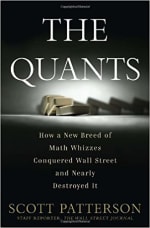

Patterson is a staff reporter for the Wall Street Journal. He has published two books on the recent penetration of Wall Street by formal mathematical models and computerized trading. The book under consideration here first laid out the history of the phenomenon for the general reading public, while the other book (Dark Pools: High-Speed Traders, A.I. Bandits, and the Threat to the Global Financial System, published two years later) delved more deeply into a number of the issues raised in the first book.
The Quants focuses on a small group of Wall Street traders who developed complex algorithms aimed at exploiting small differences in bid and ask prices that appeared due to time lags that were an inherent element of the older stock trading system. By programming modern high-speed computers to make trades based on these algorithms, they were able to tap into a comparative advantage latent in the stock market trading system as it then existed (or system bug, depending on your perspective) and get rich in the process.
The book was received with acclaim, the main reason being—not just the inherent drama of the story or Patterson’s storytelling skills—but also the fact that the book advanced the thesis that high-speed, high-frequency trading using the quants’ algorithms was largely to blame for the stock market crash known as Black Monday (October 19, 1987).
The book also explores several other, less-well-known episodes and problems, such as the 1998 collapse of the Long-Term Capital Management hedge fund and ongoing stock market volatility.
17.Steve Jobs: The Exclusive Biography
By: Walter Isaacson , 2011


Isaacson (b. 1952) is a journalist, author, and academic. Born in New Orleans, he took bachelor’s degrees from both Harvard University and Oxford University. After working for the Sunday Times in London and the New Orleans Times-Picayune, he took a job with Time magazine, where he worked for 18 years. In 2001, he was appointed chairman and CEO of CNN.
Isaacson stepped down from his position at CNN after only two years, becoming president of the Aspen Institute, where he remained until 2018. In that year, he was appointed Leonard Lauder Professor of American History and Values at Tulane University in New Orleans.
The present book is the only authorized biography of Steve Jobs (1955–2011), the co-founder, chairman, and CEO of Apple Computer, Inc., one of the driving forces behind the digital revolution of the late twentieth century. The book formed the basis of a 2015 film written by Aaron Sorkin, directed by Danny Boyle, and starring Michael Fassbender.
In addition to Steve Jobs, Isaacson has authored books on Leonardo da Vinci, Benjamin Franklin, Albert Einstein, Henry Kissinger, and Jennifer Doudna (the inventor of CRISPR technology), as well as three other books on various groups of influential persons.
18.The Entrepreneurial State: Debunking Public vs. Private Sector Myths
By: Mariana Mazzucato , 2013
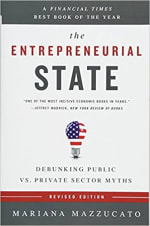

Mazzucato (b. 1968) was born in Rome, Italy. In 1972, when she was four years old, her family moved to Princeton, New Jersey, where her father had received an appointment at Princeton University’s Plasma Physics Laboratory. Mazzucato was educated in the US, obtaining her PhD in economics in 1999 from the New School for Social Research in New York City.
After graduation, Mazzucato taught at several universities in the US before relocating to the UK. Today, she is Professor of Economics of Innovation and Public Value at University College London, where she also founded and directs the Institute for Innovation and Public Purpose.
In the book under consideration here, Mazzucato uses several case histories in which the US government made major investments in technological innovations even before private sector involvement to dispel the presumption that only the private sector can successfully pursue entrepreneurship.
As a result of these successes, the author concludes that in contemporary economic circumstances the state not only can, but should, take on the role of entrepreneur in order to make the economy more just. She also argues that her findings apply to the world at large and that the governments in the developing world ought to proceed accordingly.
Mazzucato’s take-away lesson from her book is, in her own words, “If the rest of the world wants to emulate the US model, they should do as the United States actually did, not as they say they did.”
In addition to co-editing an academic volume in 2006, Mazzucato published three more books following up on the success of The Entrepreneurial State, namely, Rethinking Capitalism: Economics and Policy for Sustainable and Inclusive Growth (co-edited with Michael Jacobs), in 2016; The Value of Everything: Makers and Takers in the Global Economy, in 2018; and Mission Economy: A Moonshot Guide to Changing Capitalism, in 2021.
19.The Facebook Effect: The Inside Story of the Company That Is Connecting the World
By: David D. Kirkpatrick , 2010
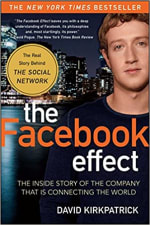

Kirkpatrick (b. 1953) is a journalist and author who specializes in technology. In 2006 Kirkpatrick met Facebook founder and CEO, Mark Zuckerberg (b. 1984). For the next two years, the author wrote frequently about the social media pioneer in a variety of magazines, including Fortune.
Liking what he read, Zuckerberg agreed in 2008 to make himself available and began to cooperate with Kirkpatrick on a book about the history of Facebook. Published two years later, the book recounts the captivating story of how Facebook began in 2004 as an idea that Harvard-undergraduate Zuckerberg dreamed up, together with several dormitory roommates, and began to make into a reality.
It then carries the story forward to the creation of a global company with 500 million users at the time of the book’s publication. The book also depicts how Mark Zuckerberg’s top priority was always the growth of his company, even at the expense of selling his equity in the early days in order to raise money from investors. However, he always remained the majority shareholder.
In 2010, a film entitled The Social Network, directed by David Fincher and starring Jesse Eisenberg as Zuckerberg, translated many of the events recounted in The Facebook Effect to the screen, although the film’s screenplay was based on a different book.
To bring the story forward, Zuckerberg became the world’s youngest self-made billionaire in 2007, at the age of 23. Facebook is estimated to have reached the one-billion-user mark in 2012, the same year that its founder took the company public. Today (as of July 2021), Zuckerberg’s net worth stands at some $132 billion, making him the fifth-richest person in the world.
20.Flash Boys: A Wall Street Revolt
By: Michael Lewis , 2014
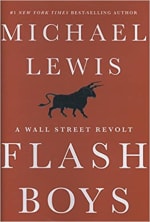

This book may be viewed as the third installment in what one might call Lewis’s “Wall Street trilogy,” along with Liar’s Poker (1989) and The Big Short (2010) (see #6 above).
This book focuses on the phenomenon of “high-frequency trading” under the control of highly refined computer algorithms—a subject also covered by The Quants (see #16 above). Lewis’s book basically brings the story as related in the earlier book up to date.
The speed of data transmission is a major factor in modern stock trading and a major theme in the book. Essentially, the faster a company’s computer system can receive and act on data, the greater will be that company’s opportunity to make a profit on trades. Nowadays, the difference between a profit and a loss on a trade may be a matter of nanoseconds (10-9 sec).
The protagonist of Flash Boys is the Canadian-born financial services executive, Brad Katsuyama (b. 1978). In 2012, Katsuyama resigned from his job with the Royal Bank of Canada in order to co-found the Investors Exchange (IEX), which he also serves as CEO. The purpose of the IEX was to provide what Katsuyama felt would be a fairer stock trading venue than the existing exchanges.
Flash Boys also focuses on Sergey Aleynikov (b. 1970), a former computer programmer for Goldman Sachs investment bank and financial services company. Aleynikov’s dramatic story—a federal prosecution for intellectual property theft and ultimate quasi-vindication in the form of an acquittal and then, upon appeal by Goldman Sachs, a hung jury—provides a frame for the book.
In the middle, we get the story of Katsuyama. In a nutshell, he figured out the ways in which the big players on Wall Street were manipulating access to certain fiber-optic cables, microwave towers, and other public IT carriers to take advantage of tiny differences in signal transmission times. This allowed insider institutions to profit at the expense of retail investors.
Lewis’s conclusion is that technological transformations and the spreading acceptance of unethical practices have transformed the US stock market from “the world’s most public, most democratic, financial market” into a “rigged market.”
21.Poor Economics: A Radical Rethinking of the Way to Fight Global Poverty
By: Abhijit Banerjee and Esther Duflo , 2011
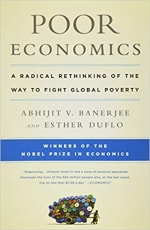

Banerjee (b. 1961) was born in Bombay (now Mumbai) to a Brahmin family of Bengali origin. His father and mother were both professors of economics. Banerjee received his bachelor’s degree in 1981 from Presidency College in Calcutta (now Kolkata), his master’s degree in 1983 from Jawaharlal Nehru University in Delhi, and his PhD in 1988 from Harvard University in Cambridge, Massachusetts. All three degrees were awarded in the subject of economics.
Banerjee is presently Ford Foundation International Professor of Economics at Massachusetts Institute of Technology. Together with Esther Duflo and Sendhil Mullainathan, he is a co-founder of the Abdul Latif Jameel Poverty Action Lab (J-PAL) at MIT.
Duflo (b. 1972) was born in Paris, France. Her father was a mathematician and her mother a pediatrician. Duflo received her bachelor’s and master’s degrees from the École Normale Supérieure and the Paris School of Economics. She received her PhD in economics in 1999 from MIT, where Abhijit Banerjee served as her adviser. After graduation, Duflo remained at MIT, where she became a full professor of economics in 2003. Today, she is professor of Poverty Alleviation and Development Economics at MIT.
In 2019, Banerjee and Duflo shared the Nobel Memorial Prize in Economics with Michael Kremer of the University of Chicago. The Nobel Prize committee wrote that the joint award was “for their experimental approach to alleviating global poverty.”
Poor Economics is devoted to the subject of global poverty and third-world development. In it, the authors attempt to construct a middle way between laissez-faire, market-based solutions and what the authors call “grand development plans” imposed top-down by foreigners.
The authors reject universal generalizations in favor of empiricism and proceeding case-by-case. They discuss the actual reasoning on the basis of which the global poor make economic decisions in such areas as healthcare, education, savings, and entrepreneurship, among other things.
The authors’ principal contention in this book is that by listening to individuals explain their own reasons for their actions, academic economists can make better sense of the economic activity of poor people in the developing world. In this way, professors can overcome the ideological commitment, mental inertia, and blatant ignorance that have often undermined their policy proposals in the past.
22.The Lean Startup: How Today’s Entrepreneurs Use Continuous Innovation to Create Radically Successful Businesses
By: Eric Ries , 2011
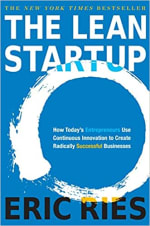

Ries (b. 1978) is an Internet entrepreneur, blogger, and author. Educated at Yale, he worked in Silicon Valley during the early 2000s for several different Internet-based companies.
In 2004, Ries co-founded the social media platform IMVU with the software developer Will Harvey (b. 1967). One of the investors in IMVU was Steve Blank (b. 1953), the creator of the “customer development method,” which relies on fast customer feedback to develop customer relationships.
Ries became friends with Blank and took the latter’s theories to heart. He applied the customer development method at IMVU, together with the concept of “lean software development,” meaning the testing of alternative versions of an online product by measuring download rates.
Out of this arose what came to be called the “lean startup movement.” The chief idea of this movement is that online product development time may be significantly shortened by implementing cycles of hypothesis-driven experimentation and iterative product releases to discover if a given business model is viable. The aim of the present book is to explain the history and the concepts of the lean startup movement to a broad audience.
One of the morals that Ries wishes for the reader to take away from his book is the following: Owners and employees of online companies have to understand that it is a mistake to “[work] forward from the technology instead of working backward from the business results you’re trying to achieve.”
Ries followed up The Lean Startup by publishing The Leader’s Guide in 2015 and The Startup Way in 2017.
23.Delivering Happiness: A Path to Profits, Passion, and Purpose
By: Tony Hsieh , 2010
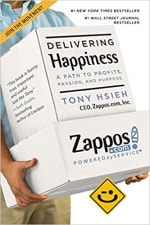

Hsieh (1973–2020) was an entrepreneur and venture capitalist. He was born in Urbana-Champaign, Illinois, to parents who had immigrated from Taiwan and met each other at the University of Illinois. Hsieh holds a bachelor’s degree in computer science from Harvard University.
Hsieh first came to public attention in 1996 with his successful startup, the advertising network LinkExchange. In 1998, when he was 25 years old, Hsieh sold LinkExchange to Microsoft for $265 million. After selling LinkExchange, Hsieh’s next project was the incubator Venture Frogs.
In 1999, a friend approached Hsieh about setting up an online website to sell shoe sales. After expressing initial skepticism, Hsieh decided to finance the idea. He also became CEO of Zappos (named after “zapatos,” the Spanish word for shoes) in 2000.
Zappos turned out to be a trendsetter in the online merchandising business and grew very quickly. In 2009, Amazon acquired Zappos for some $1.2 billion.
Among the other websites Hsieh backed financially, we may mention Ask Jeeves and OpenTable. He also invested in the jet charter company, JetSuite, and large real estate ventures in Las Vegas, Nevada, and Park City, Utah.
Delivering Happiness was Hsieh’s only book. The book is cast in the form of a memoir and combines the story of Hsieh’s life with the investment, management, and technology principles underlying his success.
A major theme of the book is the importance of being passionate and purpose-driven about one’s life and work, as well as the possibility of combining both passion and purpose with profits.
Hsieh died tragically early—at the age of 46—in a house fire. Afterwards, his friends reported that he had been struggling with drug addiction for some time. It is believed that drug use may have played a role in the fire and in Hsieh’s death due to smoke inhalation.
24.Seeing the Big Picture: Business Acumen to Build Your Credibility, Career, and Company
By: Kevin R. Cope , 2012


Cope (b. 1962) is co-founder and CEO of Acumen Learning, a leadership training company. Cope is the developer of the Five Business Drivers model, which is designed to increase owners’ and managers’ business acumen, as well as help companies improve engagement with their employees.
The five business drivers are the following:
- Cash
- Profit
- Assets
- Growth
- People
In the book under consideration here, the author claims, among other things, that owners and managers need a deep understanding of their company (what he calls “business acumen”) for several reasons.
First and foremost, business acumen is required because it contributes to the growth and profitability—in short, the financial success—of a company.
Second, business acumen is also necessary to make employees’ work more purpose-driven by highlighting how they have the power to influence the success of their work team, their department, and the entire organization.
In addition, Cope points out that purpose-driven work is inherently more fulfilling.
25.Saving Capitalism from the Capitalists: Unleashing the Power of Financial Markets to Create Wealth and Spread Opportunity
By: Raghuram Rajan and Luigi Zingales , 2003
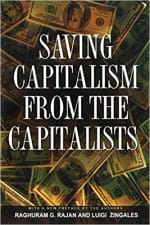

(b. 1963) was born in Bhopal in Madhya Pradesh state in India, into an Iyengar (Brahmin) Tamil family.
After taking bachelor’s and master’s degrees in India, Rajan received his PhD in 1991 from the Sloan School of Management at MIT with a dissertation on banking. After occupying academic positions with universities in the US, Sweden, and India, he entered Indian government service in 2003, eventually serving as Governor of the Reserve Bank of India from 2013 until 2016.
Today, Rajan is Katherine Dusak Miller Distinguished Service Professor of Finance at the University of Chicago Booth School of Business. Rajan has authored or co-authored six books, including the one under consideration here.
Zingales (b. 1963) was born in Padua, Italy. After taking a bachelor’s degree in economics in Italy, he received his PhD in economics in 1992 from MIT. Zingales is currently Robert C. McCormack Distinguished Service Professor of Entrepreneurship and Finance the University of Chicago Booth School of Business.
After co-authoring Saving Capitalism from the Capitalists with Rajan, in 2012 Zingales published A Capitalism for the People: Recapturing the Lost Genius of American Prosperity.
Zingales supports a mix of controversial positions associated with both the left and the right, including replacing income taxes with consumptions taxes, increasing regulation of banks, and implementing a debt ceiling.
Zingales has indicated that the growing populist turmoil in American politics might be a good thing if it created the political conditions for a reinvigoration of competition and a reversal of the increased cronyism marring American capitalism. In 2018 he debated Trump administration adviser Stephen K. Bannon at the Booth School on the topics of immigration and globalization.
In summary, Rajan’s and Zingales’s book makes the following points:
- Free markets are the best means for organizing human society and improving the human condition.
- To function optimally, free markets must be sheltered within a framework of rules that apply to all economic actors equally.
- The government must provide—and be seen to provide—the rule of law which creates this necessary framework.
- Unfortunately, governments are susceptible to capture by large private companies.
- Such private companies may be able to influence governments to issue regulations in their favor, thus distorting and subverting the free market (“crony capitalism”).
- Therefore, society must act to protect the free market from such subversion by powerful private interests.
The authors offer the following recommendations:
- Reduce the incentives of private companies to subvert markets by limiting the concentration of ownership of productive assets.
- Help maintain broad political support for free markets by providing a social safety net for those adversely affected by economic dislocations.
- Pursue free trade policies to maintain competitive pressure on American companies.
- Oppose governmental interventions in the market that protect existing economic actors at the expense of overall economic opportunity.
Interested in truly diving into the business discipline? Start by checking out the Most Influential Schools in the Field of Business over the last 20 year!
Visit our Study Guide Headquarters for tips, tools, and much more.
See our Resources Guide for much more on studying, starting your job search, and more.